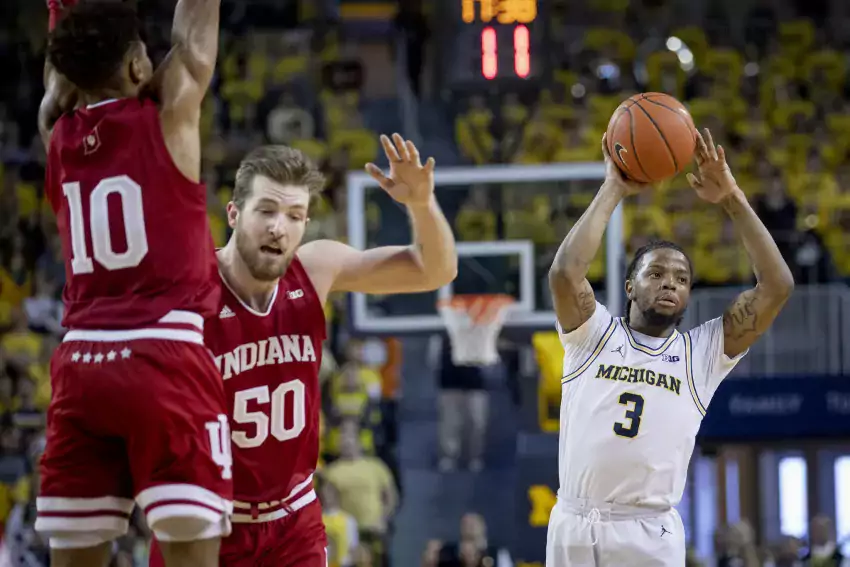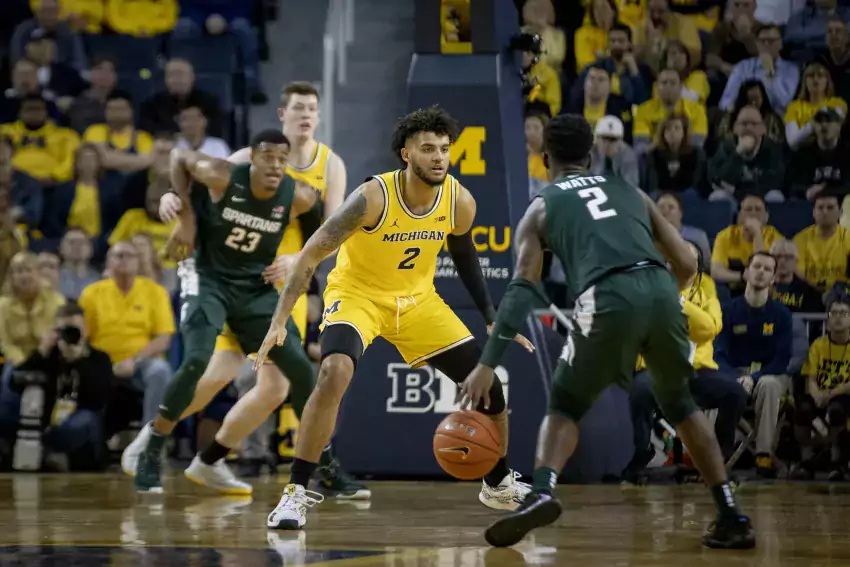around the horns

[waves hand]
You did not see this post hit the front page for two minutes earlier today right as Nojel Eastern announced his transfer plans.
Ari Wiggins Commits to WBB
The commitment video of Indianapolis Heritage Christian guard Ari Wiggins, who made her announcement earlier this week, is well worth a few minutes of your time.
Wiggins is the #12 overall 2021 player and #4 point guard on Prospects Nation and #30 overall on ESPN; both rate her as a five-star prospect. ESPN also gives five stars to Michigan's other 2021 pledge, Cincinnati guard Laila Phelia. Prospects Nation likes Wiggins a great deal whether the 5'8" guard is running the point or hunting shots:
Wiggins looks and plays vastly more mature now than she did when we first saw her as a freshman. She's a dynamic option who likes to get downhill off the bounce. Wiggins is super explosive in that regard but also showed here the ability to knockdown the open 3-pointer. A left-handed dominant guard, Wiggins gives Michigan a potential threat on or off the ball.
ESPN's robust women's hoops scouting service has three camp reports of similar ilk. They see her as an explosive combo guard:
Boo Williams Invitational-April 2019: Athletic combo-guard explodes off the dribble, brings attack mode in transition game; handles in transition, changes pace; rises on jumper in mid-range game, emerging deep threat arsenal. (Olson)
The 5'11" Phelia should also bring athleticism and scoring ability to the table, according to ESPN:
Classic-in-the-Country Challenge-January 2020: Athletic guard manufactures shots, knocks down jumpers at the arc; executes in half-court game, creates into the defense, rises over defenders and delivers in mid-range game; competes on both ends of the floor; among the elite guards in the class of 2021. (Olson)
This class follows a four-signee class of 2020 that includes ESPN five-star Cameron Williams and three others rated as four-star recruits by Prospects Nation, topped by their #40 overall recruit, guard Meghan Fiso. (I wrote plenty more on that class in my early look at the 2020-21 season.)
Kim Barnes Arico is putting together a program with the talent to make a serious run at the top of the Big Ten and a chance to make some noise nationally. The 2021-22 roster, which is projected to be led by senior versions of Naz Hillmon and Amy Dilk, looks particularly loaded. We're already pretty much there—this is looking like the golden era of Michigan women's basketball. There's ample room on the bandwagon.
[Hit THE JUMP for a couple MBB transfer possibilities, Matt Painter's bad quote, and more.]

The Defensive Turnaround: Real or Opponent-Driven?
After Brian posted this in the Rutgers game column...
Teske back? Myles Johnson isn't exactly Luka Garza but he is shooting 53% from the floor on decent usage in Big Ten play. Teske shut him off. Johnson was 0/3 and all three of his shots might have been blocked by Teske. Indiana's Trayce Jackson-Davis had as many points (4) in the first three minutes of the Indiana-Minnesota game as he had against Michigan, when he was 2/3 from the floor. IIRC not much of De'ron Davis's game came against Teske.
Tillman did okay personally from two (6/10) but MSU collectively shot 38% from two; OSU shot 44% and Wesson's twos were mostly putbacks or fadeaway jumpers.
Teske's been very rough offensively for the last month but as Michigan's defense surges he seems to be a major part of that. A return game against Trevion Williams up next will be a good measuring stick.
...I took a look at Synergy to see if there were some explanation for Michigan's defensive improvement beyond Teske simply playing better. This led to an entire post's worth of information.
The stats that leap off Michigan's defensive page are their wildly varying abilities against certain sets. They boast a remarkably good pick-and-roll defense but are among the worst power conference programs against isolations and post-ups. Here are the numbers from Synergy for M's defense, with passes included (note: Synergy separates out putbacks from offensive rebounds, so the points per possession figures are lower than you might anticipate):
| % Time | Points Per Possession | Percentile Rank | eFG% | TO% | |
|---|---|---|---|---|---|
| Pick and Rolls | 33.5 | 0.724 | 95 | 39.7 | 12.8 |
| Post-Ups | 10.8 | 0.951 | 17 | 48.3 | 8.1 |
| Isolations | 7.1 | 0.918 | 13 | 48.7 | 9.6 |
The good news: pick-and-rolls are generally better offense than post-ups and isos, so if you have to choose a play to be killer at defending, that's the right one.
After that, I wanted a good visual of Big Ten offenses and their acumen in pick-and-roll and post-up situations. I'm dire at working with anything related to Excel, so thankfully Seth put together some scatter plots for me. My (rather obvious) operating hypothesis was that Michigan would prefer to avoid good post-up teams. Here are the Big Ten's post offenses charted by frequency and efficiency:
_6.png)
Michigan's worst defensive performances have come against these teams almost without exception—the outlier is the first Michigan State game, when the Wolverines couldn't slow down the Winston/Tillman pick-and-roll. Iowa, led by Luka Garza, broke the original scale—Garza is so obscenely good in the paint that the Hawkeyes are more efficient on post-ups than any Big Ten team is on pick-and-rolls. Purdue will, indeed be a big test.
The Wolverines haven't had many of those lately. Indiana is their worst defensive performance by adjusted efficiency since the Jan. 17th loss at Carver-Hawkeye. Their next-worst game in that span: Illinois. Other than Ohio State, which the defense handled relatively well despite the loss, Michigan's recent stretch of good defense has come against teams that generally don't post up often or particularly well—Rutgers checks both boxes.
I'm worried a decent portion of Michigan's recent defensive turnaround is due to the competition. The stretch run will be a challenge. The next three games all come against post-oriented teams: Purdue, Wisconsin, and Ohio State. Then comes a respite against Nebraska before closing the season against Maryland, a very good team but one that Michigan is well-suited to defense.
[Hit THE JUMP for why that's the case, plus a look at the conference's defenses and a preview of Sunday's M/MSU WBB tilt.]

Quantifying The Livers Impact
After Brian's attempt to excise the Isaiah Livers-less games from Michigan's tempo-free stats in yesterday's game column, I figured I'd go straight to the source. Bart Torvik was kind enough to take the time to pull the exact numbers and it turns out Brian's method was a pretty solid workaround:
based on this, michigan is equivalent to the #11 team in the country when they've had isaiah livers and the #33 team when he's been out, with a particularly big dropoff on defense https://t.co/xK0KsjHbmf
— Ace Anbender (@AceAnbender) February 13, 2020
It's not a surprise that Michigan is much better with Livers than without. I did raise my eyebrows when seeing that the bigger on/off impact is on defense, though it makes sense: Livers doesn't initiate a lot of offense (though he's obviously the team's best shooter), while he's the team's best and most versatile wing defender—he's the only player who can reliably switch 1-4 without creating a mismatch for the opponent.
Add this to the evidence that, health permitting, Michigan will be a dangerous team to face in the postseason. They're still projected as an eight-seed in the Bracket Matrix, though they've moved up to a seven-seed on a good number of brackets. With Livers, they're performing more like a three-seed.
[Hit THE JUMP for the big man comparison, Duncan Robinson's outrageous shooting, and the women's team facing more adversity.]

34